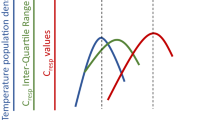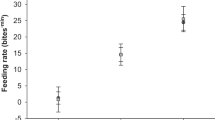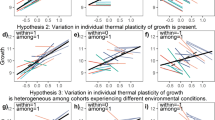Abstract
The thermal sensitivity of Arctic fish species is poorly understood, yet such data are a critical component of forecasting and understanding ecosystem impacts of climate change. In this study, we experimentally measured temperature-dependent growth and routine swim activity in the juvenile stage of two Arctic gadids (Arctic cod, Boreogadus saida and saffron cod, Eleginus gracilis) and two North Pacific gadids (walleye pollock, Gadus chalcogrammus and Pacific cod, Gadus macrocephalus) over a 6-week growth period across five temperatures (0, 5, 9, 16 and 20 °C). Arctic cod demonstrated a cold-water, stenothermic response in that there was relatively high growth at 0 °C (0.73 % day−1), near-maximal growth at 5 °C (1.35 % day−1) and negative impacts on activity, growth and survival at 16 °C. In contrast, saffron cod demonstrated a warmer-water, eurythermic response, and temperature had a positive effect on growth and condition beyond 16 °C. However, despite these distinct thermal responses, walleye pollock and Pacific cod grew 2–3 times faster than Arctic gadids across a relatively broad temperature range above 5 °C. These results, coupled with possible northward expansion by both Pacific cod and walleye pollock, suggest Arctic cod are highly vulnerable to continued climate change in the Arctic, especially in coastal areas of the Beaufort and Chukchi Seas where temperatures already exceed 14 °C in the summer growth period.



Similar content being viewed by others
References
Bain H, Sekerak AD (1978) Aspects of the biology of Arctic cod, Boreogadus saida, in the Central Canadian Arctic. Report prepared by LGL Limited for Polar Gas Project, Environmental Research Associates, Toronto
Albouy C, Guilhaumon F, Araujo MB, Mouillot D, Leprieur F (2012) Combining projected changes in species richness and composition reveals climate change impacts on coastal Mediterranean fish assemblages. Glob Change Biol 18:2995–3003
Attrill MJ, Power M (2002) Climatic influence on a marine fish assemblage. Nature 417:275–278
Barber DG, Lukovich JV, Keogak J, Baryluk S, Fortier L, Henry GHR (2008) The changing climate of the Arctic. Arctic 61:7–26
Björnsson B, Steinarsson A, Oddgeirsson M (2001) Optimal temperature for growth and feed conversion of immature cod (Gadus morhua L.). ICES J Mar Sci 58:29–38
Bluhm BS, Gradinger R (2008) Regional variability in food availability for Arctic marine mammals. Ecol Appl 18:77–96
Bouchard C, Fortier L (2011) Circum-arctic comparison of the hatching season of polar cod Boreogadus saida: a test of the freshwater winter refuge hypothesis. Prog Oceanogr 90:105–116
Bradbury IR, Hubert S, Higgins B, Borza T, Bowman S, Paterson IG, Snelgrove PVR, Morris CJ, Gregory RS, Hardie DC, Hutchings JA, Ruzzante DE, Taggart CT, Bentzen P (2010) Parallel adaptive evolution of Atlantic cod on both sides of the Atlantic Ocean in response to temperature. R Proc Soc B 277:3725–3734
Brown JA, Pepin P, Methven DA, Somerton DC (1989) The feeding, growth and behaviour of juvenile cod, Gadus morhua L., in cold environments. J Fish Biol 35:373–380
Campana SE (1996) Year-class strength and growth rate in young Atlantic cod Gadus morhua. Mar Ecol Prog Ser 135:21–26
Cheung WL, Lam VWL, Sarmiento JL, Kearney K, Watson R, Pauly D (2009) Projecting global marine biodiversity impacts under climate change scenarios. Fish Fish 10:235–251
Copeman LA, Laurel BJ, Heintz R, Vollenweider J, Boswell K (2015) Ontogenetic variability in the lipid content of saffron cod (Eleginus gracilis) and Arctic cod (Boreogadus saida) from the Western Arctic and Northern Chukchi. Polar Biol (this issue)
Coyle KO, Pinchuk AI, Eisner LB, Napp JM (2008) Zooplankton species composition, abundance and biomass on the eastern Bering Sea shelf during summer: the potential role of water-column stability and nutrients in structuring the zooplankton community. Deep Sea Res Part II 55:1775–1791
Craig PC, Griffiths WB, Haldorson L, McElderry H (1982) Ecological studies of Arctic cod (Boreogadus saida) in Beaufort Seas coastal waters, Alaska. Can J Fish Aquat Sci 39:395–406
Crawford RE, Jorgenson JK (1996) Quantitative studies of Arctic cod (Boregoadus saida) schools; important energy stores in the Arctic food web. Arctic 49:181–193
Crawford RE, Vagle S, Carmack EC (2012) Water mass and bathymetric characteristics of polar cod habitat along the continental shelf and slope of the Beaufort and Chukchi seas. Polar Biol 35:179–190
Drinkwater KF, Beaugrand G, Kaeriyama M, Kim S, Ottersen G, Perry RI, Pörtner HO, Polovina JJ, Takasuka A (2010) On the processes linking climate to ecosystem changes. J Mar Sys 79:374–388
Farrell AP, Steffensen JF (2005) The physiology of Polar fishes. Elsevier Academic Press, San Diego
Fechhelm RG, Williams BW, Daigneault, MJ Link MR (2008) Year 25 of the long-term monitoring of nearshore Beaufort Sea fishes in the Prudhoe Bay region, 2007. Report for BP Exploration (Alaska) Inc. by LGL Alaska Research Associates, Inc, Anchorage, Alaska
Folkvord A (2005) Comparison of size-at-age of larval Atlantic cod (Gadus morhua) from different populations based on size- and temperature-dependent growth models. Can J Fish Aquat Sci 62:1037–1052
Fossheim M, Primicerio R, Johannesen E, Ingvaldsen RB, Aschan MM, Dolgov AV (2015) Recent warming leads to a rapid borealization of fish communities in the Arctic. Nat Clim Chan. doi:10.1038/nclimate2647
Golovanov VK (1996) The ecological and evolutionary aspects of thermoregulation behavior on fish. J Ichthyol 46:180–187
Harter BB, Elliott KH, Divoky GJ, Davoren GK (2013) Arctic cod (Boreogadus saida) as prey: fish length-energetics relationships in the Beaufort Sea and Hudson Bay. Arctic 66:191–196
Heintz RA, Vollenweider JJ (2010) Influence of size on the sources of energy consumed by overwintering walleye pollock (Theragra chalcogramma). J Exp Mar Biol Ecol 393:43–50
Hollowed AB, Barbeaux SJ, Cokelet ED, Kotwicki S, Ressler PH, Spital C, Wilson CD (2012) Effects of climate variations on pelagic ocean habitats and their role in structuring forage fish distributions in the Bering Sea. Deep Sea Res II 65–70:230–250
Hollowed AB, Planque B, Loeng H (2013) Potential movement of fish and shellfish stocks from the sub-Arctic to the Arctic Ocean. Fish Oceanogr 22:355–370
Hop H, Tonn WM, Welch HE (1997) Bioenergetics of Arctic cod (Boreogadus saida) at low temperatures. Can J Fish Aquat Sci 54:1772–1784
Houde ED (2008) Emerging from Hjort’s shadow. J Northwest Atl Fish Sci 41:53–70
Hurst TP, Laurel BJ, Ciannelli L (2010) Thermal dependence of growth rates of early life stages of Pacific cod (Gadus macrocephalus). Fish Bull 108:382–392
Hurst TP, Munch SB, Lavelle KA (2012) Thermal reaction norms for growth vary among cohorts of Pacific cod (Gadus macrocephalus). Mar Biol 159:2173–2183
Hurst TP, Cooper DW, Duffy-Anderson JT, Farley EV (2015) Contrasting coastal and shelf nursery habitats of Pacific cod in the southeastern Bering Sea. ICES J Mar Sci 72:515–527
Hutchings JA, Swain DP, Rowe S, Eddington JD, Puvanendran V, Brown JA (2007) Genetic variation in life-history reaction norms in a marine fish. Proc R Soc B 274:1693–1699
IPCC (2014) Climate change 2014: impacts, adaptation, and Vulnerability. Part B: regional aspects. In: Barros VR, Field CB, Dokken DJ, Mastrandrea MD, Mach KJ, Bilir TE, Chatterjee M, Ebi KL, Estrada YO, Genova RC, Girma B, Kissel ES, Levy AN, MacCracken S, Mastrandrea PR, White LL (eds) Contribution of Working Group II to the Fifth Assessment Report of the Intergovernmental Panel on Climate Change. Cambridge University Press, Cambridge
Jeffries MO, Richter-Menge J, Overland JE (2014) Arctic Report Card 2014. http://www.arctic.noaa.gov/reportcard
Jobling M (1988) A review of the physiological and nutritional energetics of cod, Gadus morhua L., with particular reference to growth under farmed conditions. Aquaculture 70:1–19
Johnson SW, Thedinga JF, Neff AD (2009) Invasion by saffron cod Eleginus gracilis into nearshore habitats of Prince William Sound, Alaska, USA. Mar Ecol Prog Ser 389:293–312
Kooka K, Yamamura O, Nishimura A, Hamatsu T, Yanagimoto T (2007) Optimum temperature for growth of juvenile walleye pollock Theragra chalcogramma. J Exp Mar Biol Ecol 347:69–76
Laurel BJ, Gregory RS, Brown JA (2003) Settlement and distribution of age 0 juvenile cod, Gadus morhua and Gadus ogac, following a large-scale habitat manipulation. Mar Ecol Prog Ser 262:241–252
Laurel BJ, Stoner AW, Ryer CH, Hurst TP, Abookire AA (2007) Comparative habitat associations in juvenile Pacific cod and other gadids using seines, baited cameras and laboratory techniques. J Exp Mar Biol Ecol 351:42–55
Lowry LF, Frost KJ, Burns JJ (1980) Variability in the diet of ringed seals, Phoca hispida, in Alaska. Can J Fish Aquat Sci 37:2254–2261
Mazur MM, Wilson MT, Dougherty AB, Buchheister A, Beauchamp DA (2007) Temperature and prey quality effects on growth of juvenile walleye pollock Theragra chalcogramma (Pallas): a spatially explicit bioenergetics approach. J Fish Biol 70:816–836
Moore SE, Huntington HP (2008) Arctic marine mammals and climate change: impacts and resilience. Ecol App 18:S157–S165
Moulton LL, Tarbox KE (1987) Analysis of Arctic cod movements in the Beaufort Sea nearshore region, 1978–79. Arctic 40:43–49
Mueter FJ, Ladd C, Palmer MC, Norcross BL (2006) Bottom-up and top-down controls of walleye pollock (Theragra chalcogramma) on the eastern Bering Sea shelf. Prog Oceanogr 68:152–183
O’Connor MI, Bruno JF, Gaines SD, Halpern BS, Lester SE, Kinlan BP, Weiss JM (2007) Temperature control of larval dispersal and the implications for marine ecology, evolution, and conservation. Proc Natl Acad Sci 104:1266–1271
Otterlei E, Nyhammer G, Folkvord A, Stefansson SO (1999) Temperature- and size-dependent growth of larval and early juvenile Atlantic cod (Gadus morhua): a comparative study of Norwegian coastal cod and northeast Arctic cod. Can J Fish Aquat Sci 56:2099–2111
Peck MA, Buckley LJ, Caldarone EM, Bengston DA (2003) Effects of food consumption and temperature on growth rate and biochemical-based indicators of growth in early juvenile Atlantic cod Gadus morhua and haddock Melanogrammus aeglefinus. Mar Ecol Prog Ser 251:233–243
Peck LS, Webb KE, Bailey DM (2004) Extreme sensitivity of biological function to temperature in Antarctic marine species. Funct Ecol 18:625–630
Rand KM, Logerwell EA (2011) The first demersal trawl survey of benthic fish and invertebrates in the Beaufort Sea since the late 1970s. Polar Biol 34:475–488
Renaud PE, Berge J, Varpe Ø, Lønne OJ, Nahrgang J, Ottesen C, Hallanger I (2012) Is the poleward expansion by Atlantic cod and haddock threatening native polar cod, Boreogadus saida? Pol Biol 35:401–412
Smetacek V, Nicol S (2005) Polar ocean ecosystems in a changing world. Nature 437:362–368
Smith RL, Paul AJ, Paul JM (1986) Effect of food intake and temperature on growth and conversion efficiency of juvenile walleye pollock (Theragra chalcogramma (Pallas)): a laboratory study. J Cons Int Explor Mer 42:241–253
Sogard SM (1997) Size-selective mortality in the juvenile stage of teleost fishes: a review. Bull Mar Sci 60:1129–1157
Sogard SM, Olla BL (2000) Endurance of simulated winter conditions by age-0 walleye pollock: effects of body size, water temperature and energy stores. J Fish Biol 56:1–21
Sogard SM, Olla BL (2002) Contrasts in the capacity and underlying mechanisms for compensatory growth in two pelagic marine fishes. Mar Ecol Prog Ser 243:165–177
Springer AM, Roseneau DG, Lloyd DS, McRoy CP, Murphy EC (1986) Seabird responses to fluctuating prey availability in the eastern Bering Sea. Mar Ecol Prog Ser 32:1–12
Sundby S, Nakken O (2008) Spatial shifts in spawning habitats of Arcto-Norwegian cod related to multidecadal climate oscillations and climate change. ICES J Mar Sci 65:953–962
Wassmann P (2006) Structure and function of contemporary food webs on Arctic shelves: an introduction. Prog Ocean 71:123–128
Wong S, Walksuz W, Hanson M, Papst MH (2013) The influence of the Mackenzie River plume on distribution and diversity of marine larval fish assemblages on the Canadian Beaufort Shelf. J Mar Sci 127:36–45
Wyllie-Echeverria T, Wooster WS (1998) Year-to-year variations in Bering Sea ice cover and some consequences for fish distributions. Fish Oceanogr 7:159–170
Acknowledgments
We thank C. Ryer, T. Hurst, and I. Bradbury for reviewing earlier drafts of this manuscript. Thanks also to Bill Kopplin, Robert Fechhelm, Kyle McCain, Bill Streever and the LGL field crew for their assistance in the collection of Arctic and saffron cod in Prudhoe Bay as well as to Scott Haines, Michele Ottmar, and Eric Hanneman for their assistance in the fish transport and animal husbandry. This project was supported with funding from the North Pacific Research Board (NPRB) Grant #R1228 and 2014 Essential Fish Habitat funding from NOAA–AFSC. This study is NPRB contribution no. 560. The findings and conclusions in the paper are those of the authors and do not necessarily represent the views of the National Marine Fisheries Service.
Author information
Authors and Affiliations
Corresponding author
Additional information
This article belongs to the special issue on the “Ecology of Arctic Gadids”, coordinated by Franz Mueter, Jasmine Nahrgang, John Nelson, and Jørgen Berge.
Rights and permissions
About this article
Cite this article
Laurel, B.J., Spencer, M., Iseri, P. et al. Temperature-dependent growth and behavior of juvenile Arctic cod (Boreogadus saida) and co-occurring North Pacific gadids. Polar Biol 39, 1127–1135 (2016). https://doi.org/10.1007/s00300-015-1761-5
Received:
Revised:
Accepted:
Published:
Issue Date:
DOI: https://doi.org/10.1007/s00300-015-1761-5




